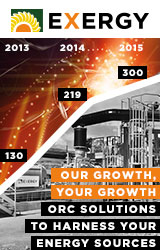Organic Rankine Cycle Systems - the latest innovative approach to geothermal energy
 With the worldwide hunt for new sources of green energy, it becomes practical to create electrical energy from geothermal sources at much lower temperatures than previously envisaged. Today, Independent power producers (IPP’s) in the USA, Turkey, Latin America, and Southeast Asia are developing thousands of MW from resources at maximum 200°C (392°F) bottom hole temperature. The main technology used for the exploitation of these lower temperature geothermal sources is the Organic Rankine Cycle (ORC), a binary cycle with organic fluid. The ORC system has proven to be the best power generating solution when the enthalpy level of the heat source is low.
With the worldwide hunt for new sources of green energy, it becomes practical to create electrical energy from geothermal sources at much lower temperatures than previously envisaged. Today, Independent power producers (IPP’s) in the USA, Turkey, Latin America, and Southeast Asia are developing thousands of MW from resources at maximum 200°C (392°F) bottom hole temperature. The main technology used for the exploitation of these lower temperature geothermal sources is the Organic Rankine Cycle (ORC), a binary cycle with organic fluid. The ORC system has proven to be the best power generating solution when the enthalpy level of the heat source is low.
Whilst steam turbines with an axial configuration have traditionally been the technology of choice for the higher enthalpy systems, the organic turbines possess the flexibility to function with lower enthalpies using axial, radial inflow, or screw expanders, and now with the radial outflow technology.
The Radial Outflow Turbine technology
Under the operating conditions typical for geothermal power production, organic fluids with high molecular weight lead to significantly lower enthalpy drops, volumetric flows, and volumetric ratios than steam. This led to the consideration of a pioneering turbine configuration for geothermal application in binary power plants. This most innovative turbine in the geothermal market is the Radial Outflow Turbine (ROT). The ROT combines the simplicity of the traditional axial turbine with the efficiency of a radial inflow turbine. The working fluid enters the turbine disk axially in its center and expands radially through a series of stages mounted on the single disk. At the discharge of the last rotor, the flow goes through a radial diffuser and is then conveyed to the recuperator and/or condensation section of the system, through the discharge volute.
The first example of this ground-breaking technology was installed at the Enel Green Power plant in Bagnore, Italy and has been operating successfully since 2012.
When working with an organic fluid, the Radial Outflow Turbine has the following advantages for geothermal application:
- Superior efficiency (up to 6% additional efficiency over the axial turbine);
- Better exploitation of high enthalpy resources and suitable for low temperature (as low as 90°C (194°F);
- Very cost effective in multiple pressure plant;
- Less maintenance; and
- Extreme flexibility for changing geothermal fluid conditions (flow, temperatures, and constituents due to a higher number of stages)
One of the most successful applications of the ROT technology in an ORC system is the AKÇA ENERJI geothermal binary plant in Denizli, southwest Turkey. Recognizing the untapped potential of its existing low enthalpy geothermal resources, AKÇA ENERJI turned to the cutting edge technology of the Radial Outflow Turbine to produce electricity to feed into the national grid.
The AKÇA geothermal binary plant
The AKÇA plant is a low enthalpy geothermal binary plant (fluid temperature at 105°C/220°F), generating a power output up to 4 MW. The standout results achieved by this plant are accomplished by the two pressure level Radial Outflow Turbine. This new turbine technology, with two pressure levels on a single expander, allows for a superior plant performance producing up to 20% more power than using a single-pressure-level system. The AKÇA plant represents the world's first binary plant equipped with a 2-pressure-level cycle on a single-disk turbine.
The successful installation of this new configuration will increase the feasibility of low-enthalpy 1-8 MW range plants down to 100°C (212°F) and open up new possibilities to exploit low enthalpy small resources more efficiently and economically than ever before. The performance tests conducted on this plant have given extremely positive results indicating a very high turbine efficiency over 5% more than the guaranteed figures provided to AKÇA.

How does the 2-pressure-level cycle on a single-disk turbine work?
The geothermal fluid is passed through the first sequence of HIGH pressure heat exchangers, passing enthalpy to the organic fluid. This organic fluid vaporizes and is passed through the HIGH PRESSURE turbine inlet. Then, the geothermal fluid is passed through the second sequence of LOW pressure heat exchangers, vaporizing the organic fluid, which is then passed through the LOW PRESSURE turbine inlet. The Radial Outflow Turbine (ROT), fed by HIGH and LOW pressure organic fluids, drives a generator to produce electrical power. The geothermal fluid is then re-injected back into the ground and the process can restart.

Anthony Hinde is international marketing and sales director for Exergy. Exergy are the developers, engineers, and producers of Organic Rankine Cycle systems with the patented Radial Outflow Turbine.
EXERGY | www.exergy-orc.com
Author: Anthony Hinde
Volume: September/October 2015











